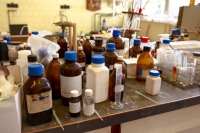Green Chemistry
What is Green Chemistry?
Green chemistry, also called sustainable chemistry, is an approach to chemistry that attempts to prevent or reduce pollution. It also tries to improve the efficiency of chemical products by changing how chemicals are designed, manufactured, and used. This chemistry emphasizes the reduction or elimination of the production of hazardous substances and the development of greener solvents and safer chemicals.
What is Green Chemistry in Schools?
Green chemistry involves teachers assessing the risks posed by the chemicals used in traditional chemistry experiments. Teachers select less-toxic materials to demonstrate green chemistry principles. By employing more environmentally benign reagents and solvents, green chemistry minimizes hazardous exposures that affect human health and the environment.
By adopting green chemistry, teachers and students learn to consider the impacts of the chemicals they work with throughout the chemical's life cycle, from use through disposal.
Why Promote Green Chemistry Education in Schools?
Chemicals are a crucial tool for science teachers educating students. But when improperly managed, chemicals in schools can be dangerous to students, staff and the environment. The green chemistry concepts can minimize the potential for chemical accidents, releases, explosions and fires. Many schools have large inventories of chemicals that often include outdated and highly hazardous substances. The green chemistry processes’ aim is to reduce, at the source, hazardous and high-risk chemicals used and stored in high school laboratories.
A green chemistry approach can save schools money by reducing the number of toxic chemicals they need to purchase, as well as reducing the need to dispose of them as hazardous waste. School administrators and teachers consider the life cycle of the chemicals used and worked with in school laboratories, from purchasing to disposal and how it can affect teachers and student’s health, potential liabilities, the impact on the environment and costs associated with disposal.
Protecting the in-school community is also part of the green chemistry approach. Students are more vulnerable to chemicals than adults. Using more benign chemicals with less human health impacts in chemistry labs and demonstrations has positive benefits for students. Green chemistry practices can prevent student and teacher absences and improve the overall indoor environment of the school. A growing body of scientific knowledge demonstrates children may suffer disproportionately from environmental health risks and safety risks.
The Next Generation
Schools need to be able to prepare students for science and technology careers. Incorporating green chemistry principles into the program of studies will give students a broad awareness of how to balance environmental, social and economic issues.
Green chemistry is the new frontier in science. It is critical for schools to begin teaching green chemistry principles to students at the high school level as the first step towards transforming how the next generation of chemists think and do business. By teaching green chemistry, today's teachers are poised to deliver new ideas in science and technology that will enhance sustainable practices.
How to Implement a Green Chemistry Program?
The first step for schools is to begin properly managing their chemical inventory. Most science departments want to do this, but they don't know how or are overwhelmed by the task. Personnel in the Tennessee Department of Environment and Conservation offices around the state can offer assistance to schools in chemical management.
As initial steps in implementing a green chemistry program, school administrators can provide training for teachers, develop and implement different policies, and budget for chemical inventory and periodic removal of chemicals. Teachers can learn about chemical hazards and safety practices, plan activities using the smallest amount of chemicals needed, and ensure the lab or classroom is equipped to handle potential chemical mishaps. Maintenance staff can learn to comply with state and local purchasing, storage and disposal guidelines and become involved with policy development for chemicals. School nurses can educate students and school personnel about chemical exposure risks and advise the elimination of mercury-containing equipment.
Government Partners
U.S. Environmental Protection Agency (EPA)
Green Chemistry
www.epa.gov/greenchemistry
Chemical Management Resource Guide for School Administrators
Building Successful Programs to Address Chemical Risks
Pollution Prevention Measures for Safer School Laboratories
Centers for Disease Control and Prevention (CDC)
Agency for Toxic Substances and Disease Registry (ATSDR)
Don’t Mess with Mercury
www.atsdr.cdc.gov/dontmesswithmercury
New York State Department of Education
Green Chemistry in Schools
www.dec.ny.gov/education/103391.html
Additional Resources
American Chemical Society
What is Green Chemistry
www.acs.org/content/acs/en/greenchemistry/what-is-green-chemistry/history-of-green-chemistry.html
Beyond Benign
Green Chemistry Education
www.beyondbenign.org/about-green-chemistry
Chemical Safety and Hazard Investigation Board
YouTube - After the Rainbow
www.youtube.com/watch?v=g6vR0BdRCNY
